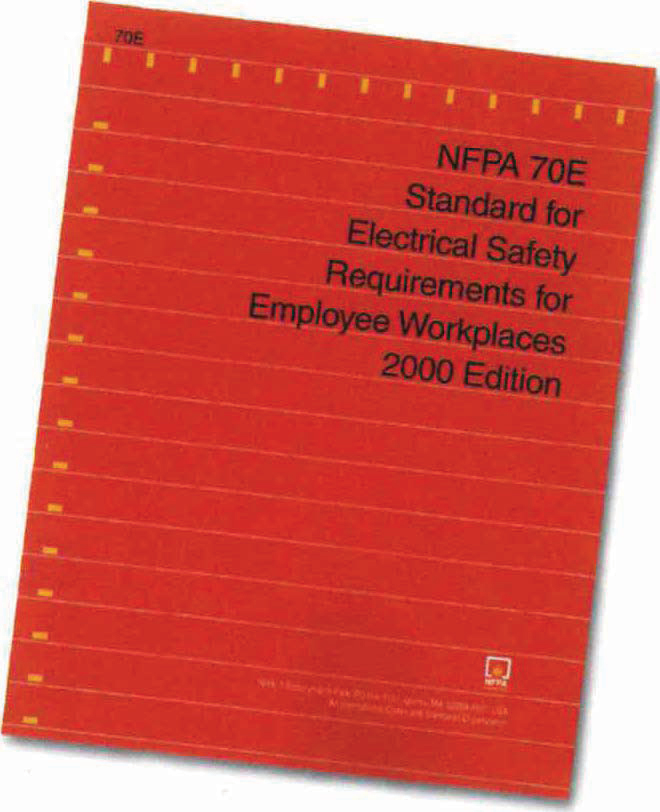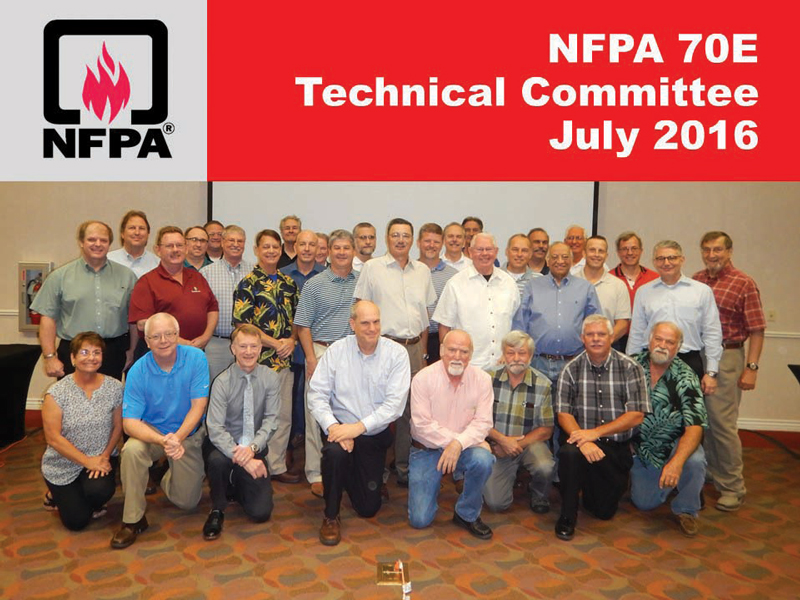The National Fire Protection Association (NFPA) is best known for the 70 standard, which is a consensus standard reviewed and updated every three years. The NFPA produces many additional standards covering topics such as Aircraft Rescue and Fire Fighting, Finishing Processes, and Wastewater Treatment Plants. There are three standards that pertain directly to electrical workers and equipment:
• NFPA 70 National Electrical Code
• NFPA 70B Recommended Practice for Electrical Equipment Maintenance
• NFPA 70E Electrical Safety Requirements for Employee Workplaces
The NFPA 70 standard, first published in 1979, was the first nationally-recognized standard for electrical safety in the US and was the reference document used for the Electrical Safety-Related Work Practices (ESRWP) regulation
(29CFR1910.331–.335). Although the CRF is a Federal law, the 70E is a standard, which means it is not legally binding.

In July of this year, another revision of the 70E is due to be published. Because of this, a lot of interest is being generated about the standard, what it will contain, and the impact any changes may have on companies and their employees.
So why should we be concerned about the 70E standard? Much of it (speaking from a monetary standpoint) has to do with the fact that if there is a nationally recognized standard and we do not follow it, we are left open for litigation if something should occur. The court would literally “throw the book at us” at trial. Another reason to use the 70E standard is that OSHA accepts the 70E and uses it as their reference, as they have members on the 70E Committee.
The 70E Committee is composed of a wide range of individuals from companies and organizations, such as the IBEW, OSHA, Underwriters Laboratories, protective clothing manufacturers, contractors, and NETA. The OSHA representatives are nonvoting and are there to advise the 70E Committee so that the standard stays compliant with the regulations. At last count, there were 24 members and ten alternates.
One observation I had at the December 70E Committee meeting was that each person on the Committee as well as the people who attended to have their views and opinions heard were committed to providing a safe work environment for all employees who have to work on or near electrical equipment. This provided an environment where people can voice their concerns without worrying that they would be ridiculed or harassed. This is extremely important in developing the best recommendations for the standard.
The real reason we should apply the 70E is because it contains the latest, and best, research and methods for working on electrical systems. No one wants to see another person injured or killed. However, we often make decisions based on our ignorance, which can have a negative consequence on our employees’ and on our future.
SOME IMPORTANT CHANGES
One of the major changes is that the current Part II, which covers electrical safety-related work practices, will become Part I. This will give more emphasis on the employee safety requirements. The current Part I, Installation Safety Requirements (basically a paraphrasing of the NEC) will become Part IV.
Some other major changes are with job sites where more than one employer is working, such as when a contractor is working at a company’s job site. Both the contractor and the site representative are to coordinate safe work procedures, including identifying existing hazards, what PPE is required, what safe work procedures are needed, and emergency/evacuation procedures. A physical meeting and documentation of the meeting is also required.
In the 2000 edition of the 70E, equipment and lines that had less than 50 volts to ground received very little mention. In the 2003 edition, it is recognized that low-voltage systems could present a hazard and, if they do, the hazards they present must be accounted for. Conductors and live parts below 50 volts must be placed in an electrically safe condition if they create any hazard. Other changes to the 70E standard include:
- 2-1.1.2, Part II. This section states that unqualified works will be allowed to work on equipment that has been placed into an electrically safe condition by a qualified worker. This was not the case in the 2000 version.
- 2-1.3, Part II. This section has been reorganized.
- 2-1.3.1 through 201.3.3, Part II, Electrical Hazard Analysis. This section requires that both a shock hazard analysis and a flash hazard analysis be performed before any person approaches the Flash Protection boundary. It also requires that the employer document the incident energy exposure at the working distance and what PPE is being used. The Hazard/Risk tables can be used as an alternative. Annex B, the new IEEE 1585 Guide (parts of which are contained in Annex B) or the new Table 2-1.3.3.2 may be used as well as any of the available computer programs.
- 2-1.3.6, Part II (new), Energized Electrical Work Permit. This section states that any work performed within the flash protection boundary requires an energized electrical work permit. An exception was added that allows troubleshooting and diagnostic work to be done without a permit if the worker is protected by performing a hazard analysis. 2-1.3.6, Part II refers the reader to Appendix G for an example form.
- 2-3.2.1, Alertness. This section prohibits allowing employees to work in areas containing live parts if their alertness is impaired due to illness, fatigue, or other reasons.
- 2-3.4.2, Part II, Conductive Articles Being Worn. This section states that unrestrained conductive eyeglass frames are prohibited if they post an electrical hazard. Plastic frame glasses, although not specified, are implied when someone works on or near energized equipment. The wording “unless such articles are rendered nonconductive by covering, wrapping or other means” will be deleted.
- 3-3.3, Part II, Head, Neck and Face Protection. This section now includes face, neck, and chin.
- Table 3-3.9.1, Part II. Many revisions are being made to this Table. When the incident energy exceeds 40 cal/cm2, a new Note 7 is applicable, which reads, “The degree of hazard and risk is too great for this task to be performed while the circuit is energized. This task must be performed only with the equipment in an electrically safe work condition.” At one point, the Committee considered adding a Hazard/Risk Category 5, which would be used when arc energies exceed 100 cal/cm2. It was decided that the hazard from the acoustic wave (blast) of an arc would, at that point, be primary hazard, so the HRC 5 category would not be appropriate.
- Table 3-3.9.1, Part II also adds notes for diagnostic testing and other types of equipment, such as watthour meters.
- Table 3-3.9.2, Part II. This Table changes wording to allow wearing of other types of clothing besides cotton.
- Table 3-3.9.3, Part II. This Table deletes a column calling out fabric weights to allow for newer clothing systems that may weigh less that previous ones did.
- 3-3.9.4.1, Part II, Layering. This section allow nonmelting, flammable clothing to be worn as underlayers.
- 3-3.9.4.3, Part II, Underlayers. This section allows a small quantity of meltable fibers to be used in undergarment waistbands. There is still a hazard when any meltable fiber is work, as the heat from an arc can be sufficient to melt such clothing, even through flash protective clothing and equipment.
- 3-3.9.4.4, Part II, Coverage. This section requires coverage for the wrists and neck.
- 3-3.9.5.2, Part II, Flash Suits. This section requires that flash suits and their face shields have adequate thermal rating. Face shields were not specifically called out in the previous edition.
- 3-3.9.5.3, Part II, Hand Protection. Leather gloves are required for flash protection. Rubber insulating gloves are required as needed for shock protection.
- 3-3.9.7.2, Part II, Flammability. This section allows the use of cotton or other nonmelting, flammable clothing where work is performed on Class–1 and Class–0 systems and the incident energy is expected to be less than 2 cal/cm2. The 2 cal/cm2 value is not intended to be an arc-thermal rating for cotton, by the way. Cotton, wool, or other flammable material does not provide protection from an arc, it only does not increase the extent of the injury by igniting and melting onto your skin.
- Annex B, Part II. This section now includes the text portion of IEEE 1584-2002. The new portions are added after B–6. In my opinion, this annex is of limited benefit. If the 1584 Guide is going to be used, the calculators that are included are much handier.
CONCLUSION
This is by no means a complete, or even thorough, look at the new 70E. There are too many changes recommended that would take too long to detail, but the changes included here are some of the more important ones that I believe managers should look for. As this article is being written, the full 70E Committee is sending their ballots in for a final vote, It is possible that some of the proposed changes to the standard will not pass, so do not make any changes yet. As always, everyone should strive to provide a safe work environment, regardless of the status of the OSHA regulations or standards.

Jim White wrote this first 70E & NETA column for the Spring 2003 issue of NETA World. He went on to write 72 consecutive 70E & NETA articles, most co-authored with Shermco Industries’ Ron Widup. Jim also authored numerous feature articles for NETA World and provided an article for every Training Talk issue from Summer 2017 through Fall 2020.
 James (Jim) R. White was nationally recognized for technical skills and safety training in the electrical power systems industry. At time of this article, he was the Training Director for Shermco Industries, a NETA Full Member company, and spent his nearly 40-year career directly involved in technical skills and safety training for electrical power system technicians.
James (Jim) R. White was nationally recognized for technical skills and safety training in the electrical power systems industry. At time of this article, he was the Training Director for Shermco Industries, a NETA Full Member company, and spent his nearly 40-year career directly involved in technical skills and safety training for electrical power system technicians.